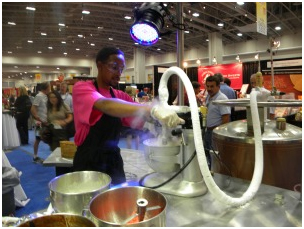Cell phone:+8617329375552
TEL:+86-373-5871333
P.C:453000
E-mail: info@jxcryo.com
Add: Chenbao Industrial Park,Xinxiang City,Henan Province,China.

- +8617329375552
Liquid Nitrogen : making ice cream the physicist's way

Making ice cream with liquid nitrogen is a delicious way to observe the phenomenon of phase transition, but the real reason physicists make ice cream that way is that it looks darn cool at a party. This is a discussion of my latest experiment with ice cream to clarify the process for people who might be interested in trying it.
1 - Get the liquid nitrogen. That's the toughest part. Liquid nitrogen (LN2) is cheaper than milk, but you can't buy it at the grocery store. We use it to cool down sensitive cameras for spectroscopic experiments in our lab, so we have an easy access to it at the university. It usually comes in big containers of 70 liters, so for the party we have to carry it in a smaller container. For the recipe, we will need 2 to 5 liters of LN2, which we can carry in special thermos-like bottles. Never, ever put liquid nitrogen in a closed container! The pressure will build up and the container will explode with LN2 flying everywhere (I know this by personal experience). The cap of our thermos bottle has a hole in it, so the pressure is regulated.
2 - Make the ice cream base. This is the recipe I used :
· 1 liter of half and half (10% fat cream)
· 0.5 liter of heavy cream (35% fat cream)
· a pinch of salt
· 1 cup of sugar
· real vanilla extract, to taste (or other flavor)
Stir all the ingredients together until the sugar dissolves. I suggest you chill this mix in the fridge until you are ready to make the ice cream, unless you have plenty of LN2. Note that this recipe feeds 20 persons, feel free to halve it.
3 - It's time for the show. Pick an assistant and make her wear protective goggles and cryogenic gloves (or just mittens). While you slowly pour the LN2, your assistant has to stir constantly with a whisk or a wooden spoon. That's the key to make good ice cream : the ice crystals must be small for the ultimate fine-textured ice cream, so keep stirrin'! The mixture will boil, so be sure to use a big metal bowl to avoid spilling (some plastics might not resist those cold temperatures). When the mix is to thick to use a whisk, stir vigourously with a wooden spoon. Keep pouring slowly LN2 until it is the consistency you like.
LN2 boils at -196 degrees Celcius (77 Kelvin), and in order to change from a liquid to a gas, it has to absorb some energy (5.56 kJ per mole, to be exact). It thus takes this energy away from the cream, which cools it. By losing thermal energy, the cream will eventually turn into a solid, what we scientists call "ice cream". ;-)
4 - Taste test. Mmmm-mmmm! The recipe I used was totaly improvised and worked out beautifully. Try it!
Concerns about liquid nitrogen
Some people might have some questions and concerns about using LN2 for making food. Let's examine them.
· "Will I die if I eat it (the ice cream)?"
No. Let the LN2 completely boil off (evaporate) and there is no danger for eating the ice cream.
· Are those plumes of Halloween-looking smoke coming off the bowl going to gobble up all the oxygen in the room? Are we all going to go to sleep and never wake up?
No. The air we breathe is made of 79% nitrogen, so if you let a liter or two of liquid nitrogen evaporate in a room, it won't make much difference to what you normally breathe. But if someone spills a 4 foot high hardcore nitrogen tank in your kitchen, open the window.
By the way, the Halloween-looking "smoke" is nothing more than water vapor that condensates into small clouds. The same thing happens is you open your freezer on a hot and humid day, or when you exhale outside in winter at -30 degrees Celsius.
· You need to treat it as seriously as you would a deep fryer filled with hot oil and the like.
Good point, you should be very careful when handling LN2. But there is a big difference between hot oil and cold liquid nitrogen. If you spill hot oil on your bare hand, you will get burned real bad. If you spill liquid nitrogen on your bare hand, you won't get hurt. Why? The LN2 doesn't actually touches you : the droplets float on a small air cushion between itself and your hand. You can observe the same phenomenon if you spill a couple of drops of water in a very hot pan : the droplets float on a cushion of vapor. That being said, don't try to keep the LN2 in the palm of your hand, it will freeze your skin and that's not cool.







